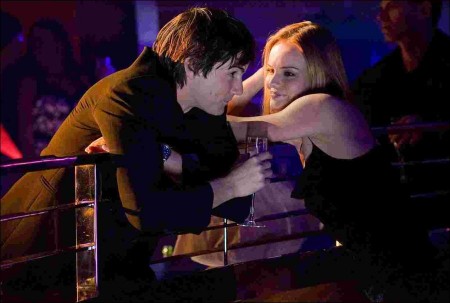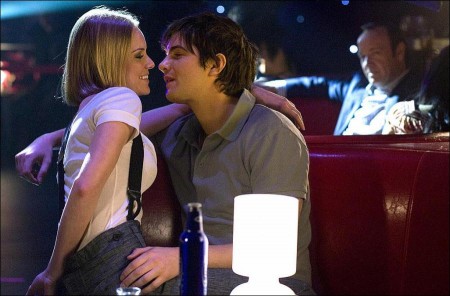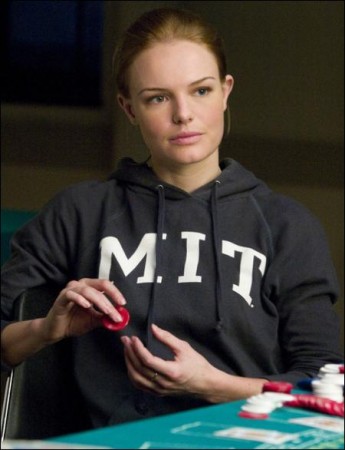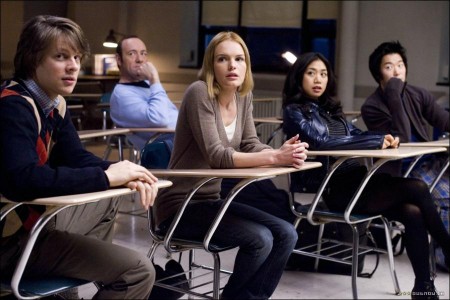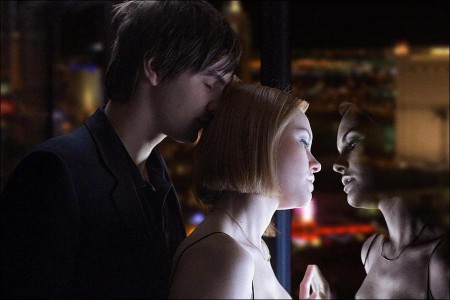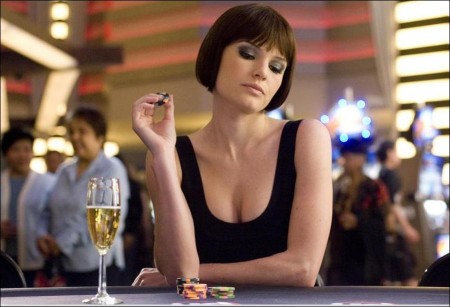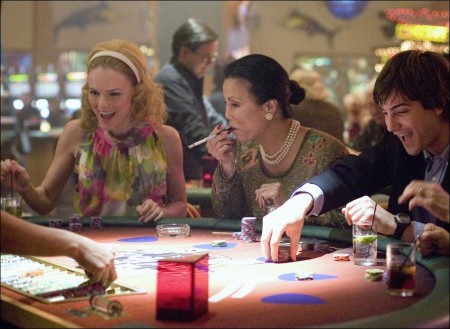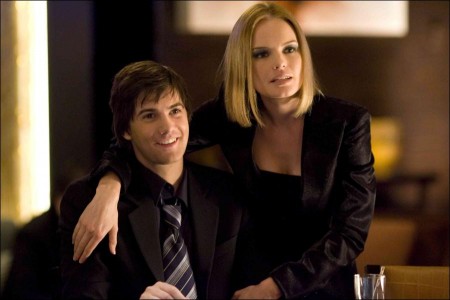Tagline: Inspired by the true story of five students who changed the game forever.
“21,” based on Ben Mezrich’s best-selling nonfiction book “Bringing Down the House: The Inside Story of Six M.I.T. Students Who Took Vegas for Millions,” revolves around a group of young men who become experts in the art of card counting.
Ben Campbell is a shy, brilliant M.I.T. student who — needing to pay school tuition — finds the answers in the cards. He is recruited to join a group of the school’s most gifted students that heads to Vegas every weekend armed with fake identities and the know-how to turn the odds at blackjack in their favor. With unorthodox math professor and stats genius Micky Rosa (Kevin Spacey) leading the way, they’ve cracked the code.
By counting cards and employing an intricate system of signals, the team can beat the casinos big time. Seduced by the money, the Vegas lifestyle, and by his smart and sexy teammate, Jill Taylor (Kate Bosworth), Ben begins to push the limits. Though counting cards isn’t illegal, the stakes are high, and the challenge becomes not only keeping the numbers straight, but staying one step ahead of the casinos’ menacing enforcer: Cole Williams (Laurence Fishburne).
About the Film
“Who wouldn’t want to go to Vegas and make a killing, not because of luck, but because you’re smart about it?” asks Kevin Spacey, describing the appeal of the story behind 21. Spacey says that though it seems like fantasy wish-fulfillment, in fact the film is inspired by a real group of M.I.T. students in the 1990s. “I loved the juxtaposition between these kids’ lives in Boston – where they were geeks with pencils in their pockets – and the lives they make for themselves in Vegas, where they can become anybody they want to be.”
“You can become anyone you want in Vegas,” says Robert Luketic, who directs the film. “M.I.T. geniuses become rock stars. They’re given the keys to Las Vegas. They have access to things that most of us can only dream of.”
Long ago, Spacey’s producing partner, Dana Brunetti, had heard the rumors about the M.I.T. math gurus who had used their skills for a very concrete purpose: they had figured out how to beat the odds at blackjack and take the Vegas casinos for millions. “Ever since I started playing blackjack, I’ve been fascinated by the fact that it’s beatable,” says Brunetti. “Then, by chance, a friend of mine was having dinner with a guy who used to be a card-counter on an earlier team. I thought right away that it was a great idea for a movie.” Brunetti knew that the story would interest Spacey, “but it didn’t go anywhere until Ben Mezrich wrote his story for Wired magazine.”
Mezrich’s article appeared in the September 2002 issue of Wired. As it chronicled the budding geniuses at M.I.T. who had beaten Vegas at its own game, Mezrich’s tale had everything – featuring high stakes action, incredibly close calls with Vegas security staff, and the up- and downsides of a glitzy, glamorous Vegas lifestyle, Mezrich’s article was a true story that read like a Hollywood thriller. Immediately struck by the possibilities, Brunetti contacted Mezrich, but the author’s first impression was that one of the students was playing a prank (something that would not be out of character for an M.I.T. student).
“This guy calls me up and says, ‘Hi, I’m Dana Brunetti, and I have Kevin Spacey on the line.’ Yeah, right. I take down his number and say I’ll call him back. So I Google ‘Dana Brunetti’ – and he really is working with Kevin Spacey!” Brunetti and Spacey had soon locked up the rights to the article.
Coincidentally, Luketic also read the Wired story and thought it would be a great movie. “I’d just gotten back from touring Europe to support Legally Blonde and was looking for my next project. I read in Wired magazine about a team of brilliant M.I.T. students who’d beaten the house in Vegas – but when I called, I found out that Kevin Spacey had already bought the project. Years passed, but then a script landed on my desk and it all came back to me. I guess it was meant to be.”
Producer Michael De Luca explains that the book taps into everyone’s Vegas dream of beating the house. “I’ve always been a blackjack fan,” he says, “so after I read the book, I tried to pick up the counting method from the book. It’s hard for someone who’s not a math genius, but it’s infectious. The few times you get the count right and you hit a hand for a lot of money, it feels really good.”
When Mezrich’s book hit the shelves, it became a phenomenon, staying on the bestsellers list for 59 weeks and moving 1.5 million copies. Translated into twelve languages, the book continues to enjoy strong sales.
In order to adapt Mezrich’s nonfiction book into a movie, the filmmakers made certain changes to the story, but the filmmakers point out that their dramatic license doesn’t change what has made the book so popular. “This is a fun movie – it’s not meant to be a docudrama,” says Dana Brunetti. “We made some changes to the real story in order to make it work as an entertaining movie. We set the movie in the present time and added a romantic element. But we never touched the heart of what made the story so exciting: the tense action, the high stakes, using fake identities and bravado to rise to the top in the fast-paced world of Vegas, beating the house and making millions. That’s what the book is, and that’s what the movie is, too.”
The book and the movie are both inspired by the experiences of Jeff Ma, who was a student at M.I.T. in the mid-1990s when he was recruited to join the blackjack team. Though Ma and his teammates were some of the brightest minds in the country, to succeed with the team, they would require something else. “I think the real reason that I was recruited to join the team was because they thought I would be good at it, not just because of my intelligence, but because of my demeanor and my ability to go into a casino and sell myself,” he says.
While on the M.I.T. team, Ma was the big player; once his teammates, called spotters, had found a hot deck, Ma would sit down and play very high wagers with the odds in his favor. Ma says that he had to overcome the natural parts of his personality to play the big player convincingly. “There was always the fear, rational or irrational, that we would get caught,” he says. “I’m the type of person that doesn’t like to get yelled at by anyone. So regardless of whether the casinos have any ability to cause you physical pain, that fear is always in the back of your mind.”
The M.I.T. team changed Ma’s life, not only while he was on the team, but for the future as well. “I think a lot of people work at jobs they don’t really like to earn a paycheck,” he says. “Because of blackjack, I’ll never have to take a job like that. I had enough money that I could do what I wanted to do – coach water polo, and then start a sports company. I’ll never have to take a job that I don’t enjoy purely for the money. That’s the greatest gift that blackjack gave me.”
Ma is no longer allowed to play blackjack in most casinos in Las Vegas – though the casinos welcome him at other games, he can’t play his best game. For Ma, the thing he misses most isn’t the blackjack, but being part of the team. “We were a group of 10 or 20 kids – literally kids, 21 years old – managing a multimillion-dollar company, trying to make it work and trying to make more millions. I miss that camaraderie.”
To direct the film, the producers looked to Robert Luketic. Producer Michael De Luca says that he, Brunetti, and Spacey were attracted by Luketic’s vision for the film. “21 spans many genres, many tones,” he says. “It’s a suspense film with action, comedic, and romantic elements, and it’s inspired by true events. Even with all of those balls in the air, Robert was able to balance it into one unified vision.”
“I had directed several romantic comedies and was eager to try something different,” says Luketic. “With everything that 21 had to offer – high stakes tension, close calls, and the fantasy-come-true of giving Vegas a taste of its own medicine, it seemed like a tremendous opportunity.”
Kate Bosworth, who previously worked with Luketic on Win a Date with Tad Hamilton, says, “He’s created this incredible balance of being extremely professional and serious when he needs to be, but really he’s just a little kid at heart. I love that! I really feel like people with that kind of personality often make the best films because they make it fun.”
She continues, “Robert has a great sense of humor. I feel like I can try anything when I’m with Robert and that’s not something I can say for everybody.”
Casting The Film
Taking on the lead role is Jim Sturgess, who previously starred for director Julie Taymor in Across the Universe. Luketic says that Sturgess is on the cusp of a breakthrough as a major star. “He’s the complete package,” says the director. “He’s dramatically spot-on and comedically gifted, which is a rare combination. He has a real passion to him; as a director, I look for that passion, that love, that excitement, that need and desire. With that passion, in addition to his talent and his charisma, I knew he’d be perfect for the role.”
Sturgess recalls, “I sent out an audition tape, not expecting anything to come of it. Then, I got a phone call saying that Robert wanted to meet me. We had breakfast together in London, I did a few screen tests, and then they offered me the part.”
Sturgess says that his character has a “genius mind,” but that’s not enough. “He’s at a point in his life when his brain can only take him so far,” he says. “He needs something else about him, about his personality, to give him an edge – more than just having good grades on a piece of paper.”
In the film, the characters take on disguises to help them elude Vegas enforcers. For Sturgess, that was one of the most interesting challenges of 21: the chance to play many characters within one film. Sturgess says that his costume helped him find the role. “When you’re in a classroom with a shirt and a hoodie, it helps you feel like an M.I.T. student. When you’re in the bright lights of Vegas in an Armani suit and thousands of dollars in your pocket, it definitely helps you to make the transition.”
Opposite Sturgess in the role of Jill Taylor is Kate Bosworth. After co-starring with Spacey in Beyond the Sea and Superman Returns, landing Bosworth for the role was as simple as a phone call. Bosworth remembers, “During Superman Returns, Kevin mentioned this project. Quite a while later, I was wrapping up another film and planning to take a holiday when Kevin called. His exact words-‘Will you please come play in Vegas and Boston?’ It was quite difficult to say no.”
Describing the appeal of the project, Bosworth says, “Everyone likes to see a group of ordinary people beat the system and that’s what these kids did. It’s extraordinary, almost unbelievable, but true.”
In an ensemble film like 21, Bosworth says, the relationship between the actors is as important as the actors themselves. “Because the story is about a group of kids who have known each other for a long time, who trust each other completely, this movie really depends upon the chemistry of the cast to pull that off,” she says.
“Kate is a movie star – she brings her megawatt charisma and Hollywood glamour to that role,” says De Luca. “But she also has gravity, bringing a level of character acting that you don’t find in too many actresses. We were lucky to have her.”
“It’s always a pleasure to work with Kate,” says Spacey. “She’s very beautiful, fiercely intelligent, incredibly talented, and a load of fun to hang with in Vegas for three weeks. I was thrilled that it worked out.”
Spacey, of course, always intended that he would play the supporting role of Micky Rosa, the mad genius and stats nut who puts together the M.I.T. team in the film. “The character is an amalgamation,” he notes. “The character is a combination, a compilation of several real people and imagination – partly my imagination, I hope, since I play him.”
Spacey says that with no real math skills upon which to base his performance, “this is acting at its best. Actually, I failed basic math in my last semester in high school, so the idea that I could count cards is fairly ludicrous. Still, I hope, you believe it.”
Laurence Fishburne, a seasoned veteran with a huge fan base, was also happy to join the cast, thanks to Spacey’s involvement.
He offers, “I’ve known Kevin Spacey for a long time. We travel in the same circles and have mutual friends. I’ve admired and respected him, but we never worked together before so I was excited at the chance to come and play with him.”
“I’m not a big gambler, but there’s something sexy about that life and the gambling culture,” adds Fishburne. “Playing this part is a way to be involved in that world.”
Spacey says, “I’ve always wanted to work with Laurence Fishburne. One of the things I admire about him is the places he goes to create his characters, giving them a history, depth, and weight.”
Aaron Yoo, who co-starred in last year’s blockbuster hit Disturbia, was cast as Choi. Liza Lapira, most recognized for her turn in the Showtime series Huff, plays Kianna. Jacob Pitts, who starred in the comedy Eurotrip, is Fisher.
Yoo says, “I read the book when it came out and later found out that Kevin Spacey had optioned it. I called my agent and said that I hoped there was a part in this movie for me, if it ever gets made. Well, years later, I’m in Sundance, insanely busy, when my agent calls – can you make an audition tape and FedEx it to L.A. They want you for that project you told me about a million years ago. I ended up flying straight from Park City to Vegas for the table read. It was out of control.”
Yoo adds that he was excited about the way 21 told its story in an entirely fresh and original way. “In my experience, college is all about separating yourself from what you were and figuring out what you are. There’s something about that in this movie that I grab onto.”
Pitts says that the attraction for him was the way that the film was different from so many other current films set in Las Vegas. “So many movies set in Vegas are full of hard-boiled characters, jaded by the world they live in. In 21, the characters are, essentially, kids. They are living the lifestyle, but without the pain behind it. The movie is about their introduction to that side of the city – their innocence going through a grinder.”
About The Production
Two weeks prior to filming, the five actors who play the M.I.T. team of card counters spent time with card consultant Kyle Morris to learn how to play the game. Morris, who lives in Las Vegas and consults for films, worked closely with the cast during filming and appears as a blackjack dealer in one scene.
Regarding learning the game, he offers, “The cast really surprised me. A lot of them knew absolutely nothing about blackjack but they knew quite a bit about acting. It was more important to teach them how to look and act like a blackjack player.”
Jim Sturgess admits, “I had never played blackjack before in my life. Kyle taught us basic strategies-how to hold yourself at a table, how to do the signals-just to make us looked relaxed at a blackjack table.”
Jacob Pitts explains, “Last time I played blackjack I was twelve years old. Kyle taught us basic strategies and all the signals, but he also showed us techniques for moving chips and manipulating them – the kind of moves that you pick up when you spend a lot of time in casinos.”
The one person who didn’t pick up the chip tricks is Jim Sturgess. “I asked Jeff Ma about it and he said, ‘No, I never did those kinds of tricks. I was the big player – if I was doing chip tricks, they would have sniffed me out,'” he remembers.
Liza Lapira says, “Before being in this movie, I never thought playing blackjack was fun. But thanks to ‘research,’ we got to go to a lot of cool places. It didn’t feel like we were working!”
Kate Bosworth laughs, “The research we had to do on this film was to learn how to play blackjack with real blackjack players in Vegas. How tough is that? I’ve been to Vegas and have gambled a bit, but now I feel like I somewhat know what I’m doing.”
Morris reveals, “A couple of the cast took it even further. Aaron and Liza practiced their card counting. A couple of times I’d spread the cards out and Liza would tell me what the count was and she would be right!”
Lapira isn’t so sure in her skills. “I got Beat the Dealer, the famous book by Edward O. Thorp, and tried to count cards. I’m sure I looked like a big freak in the Santa Monica Coffee Bean, counting to myself.”
Morris says that the cast did have some success at the tables. “I know some of the people in the cast had some big wins while we were in Vegas and chalked it all up to research,” he says. “Hopefully, later on, they won’t blame their losses on me.”
Once filming got underway, it was important to the filmmakers to shoot in real casinos whenever possible. Initially, the filmmakers were concerned that Vegas honchos would not want to cooperate in the filming of a story that shows them being taken by card-counters. “What we soon found out is that the casinos actually liked the story, because it makes people think they can beat the system, and do it easily. That helps bring the people into the casinos,” says Brunetti.
When filming began in Las Vegas, one of Luketic’s challenges was to capture the chaos of Sin City. “You can never completely shut down a casino,” says Luketic, “but we were able to get a table or two or a small section. We’d be filming at one table, orchestrating a complicated camera move, and at the next would be a bunch of frat boys having a great time. The casinos were great partners and helped us tremendously – I’m very proud of what came out of our two weeks in Vegas.”
Capturing the complicated tracking shots between tables and doing it in a highly stylish, sophisticated, brightly colored way was Academy Award®-winning cinematographer Russell Carpenter, ASC. “Vegas never closes – the casinos have business 24/7. The key challenge was to shoot our scenes without interrupting the business going on around us. It was exciting.”
Carpenter adds that they were able to find creative and unique ways to achieve the look that Luketic wanted through very unusual means. “We found that we could add a lot of sizzle to our scenes by shooting a long lens through a 35-cent light-up Twizzler that we bought in a hotel gift shop,” he says. “It looks great, like you’re shooting through miles of neon.”
“Robert’s directing style on set in Vegas was very relaxed,” notes producer Dana Brunetti. “He’d arrive completely organized and knowing what he wanted to get, but at the same time, he would be open to new ideas and see where a performance would go. He created an atmosphere that was both loose-and-lively and methodical, and that kept things moving stress-free amid the pandemonium of Vegas.”
Luketic says the best-selling book had all the dramatic moments and tension the film needed, but to translate the story to film required him to make creative decisions on how to bring the internal world of card counting to the screen. “Blackjack really isn’t a spectator sport, but we had to make it into an arena game,” he says. “We asked ourselves, ‘How do we visualize genius? How do we get inside our lead character’s mind?’ Using specialized lenses and cameras and CGI, we were able to get right onto the surface of the cards and into the characters’ eyes. As a filmmaker, 21 challenged and pushed me.”
Production Designer Missy Stewart, who previously collaborated with Luketic on Legally Blonde, Win a Date With Tad Hamilton, and Monster-In-Law, was responsible for presenting Vegas’s glitz on the screen. “We talked about how in Las Vegas there would be a lot of camera movement, the kids would be on the go, in a very animated, almost psychedelic environment.
“What you’ll see is what I consider the ‘new Las Vegas,’ which is the Las Vegas that the younger people go to for a weekend. It’s very different than the old casinos,” Stewart continues. “The Red Rock Resort & Casino, the new Planet Hollywood, the Hard Rock-all hip, fun places to go to and to be seen in.”
Contrasting with the hyper-realized Vegas is a very controlled, quiet look for the Boston sequences. “Boston has the traditional look of a 19th Century city,” she says. “We embraced the idea that most of our Boston work would be in older buildings, like Doyle’s Tavern, that has been around since the 1800s.”
Carpenter concurs, “My favorite part of this movie has been establishing a different look for what we shot in Vegas and what we shot in Boston. We use a different color palette and a different way of shooting for the energy of Vegas versus the sense of enclosure that our character, Ben, feels in Boston.”
Luketic adds, “Working in two distinctly different locations was a challenge. But ultimately, with this highly talented group of filmmakers and cast behind me as well as the cooperation of the casinos and the cities of Boston and Cambridge, I think we have a great looking and exciting movie.”
Differentiating styles was equally important for Costume Designer Luca Mosca. After all, he was responsible for helping the actors transform from M.I.T. students into Vegas’s highest rollers. “It was great fun to create the chameleon quality of these kids from one environment into the next,” he says.
But changing the students into the coolest kids on the block is just one transformation. In fact, even as a student, Ben changes over the course of the film as he becomes more self-assured. “It was especially challenging to gradually build Ben, our lead, from a plain student in a maroon M.I.T. sweatshirt into a student with a new degree of confidence without revealing too much,” Mosca notes.
For the actors, donning their Vegas identities was part of the fun. Kate Bosworth says, “One of my favorite things about the project was the fact that the students disguised themselves so that they wouldn’t be recognized by the casinos. I had my ‘Southern Belle’ look, my ‘Soprano-Jersey Girl’ look, and my ‘Louise Brooks’ look. It was fun!”
How Card Counting Works
In 21, the spotters play low-wager bets, counting the cards and waiting for the deck to become hot – the more face cards left in the deck, the hotter the deck is. Once a face card is played, the spotters score it -1. Cards 2 through 6 are +1. 7, 8, and 9 are neutral and have no value.
Once the deck is hot, the spotters cross their arms to signal the big player. He comes in, flashes his cash, and makes high-wager bets on the hot deck, leaving and bouncing to another table when the cards are shuffled. The spotters signal the big player by speaking in code to let him know what the count is:
+1 = Tree +10 = Bowling
+2 = Switch +11 = Football
+3 = Stool +12 = Eggs
+4 = Car + 13 = Witch
+5 = Glove +14 = Ring
+6 = Gun +15 = Paycheck
+7 = Craps +16 = Sweet
+8 = Pool +17 = Magazine
+9 = Cat +18 = Voting Booth
For example, if the count is +15, a spotter might give the big player a clue by pretending that he has lost money at the table, saying, “I’ve blown my whole paycheck. My girlfriend is going to kill me.”
If a spotter needs to talk to another team member, the signal is to touch the eye. If the spotter sees that the big player has lost the count, the spotter can signal that the deck is cooling with a hand to the forehead. And if a team member sees that the dealer, or the pit boss, or security has figured out what’s going on, the signal is fingers through the hair: Get. Out. Now.
Production notes provided by Columbia Pictures (Sony).
21
Starring: Kevin Spacey, Laurence Fishburne, Kate Bosworth, Liza Lapira, Josh Gad, Jim Sturgess, Masi Oka, Sam Golzari
Directed by: Robert Luketic
Screenplay by: Peter Steinfeld, Allan Loeb
Release Date: March 28th, 2008
MPAA Rating: PG-13 for some violence, and sexual content including partial nudity.
Studio: Columbia Pictures (Sony)
Box Office Totals
Domestic: $81,159,365 (51.4%)
Foreign: $76,643,105 (48.6%)
Total: $157,802,470 (Worldwide)
